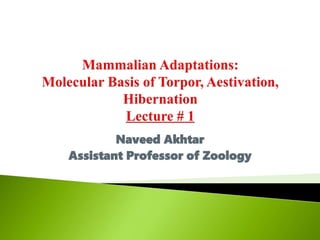
Torpor Mechanisms and Adaptations
- 1. Naveed Akhtar Assistant Professor of Zoology
- 3. Torpor is a state of decreased physiological activity in an animal, usually by a reduced body temperature and metabolic rate. Torpor enables animals to survive periods of reduced food availability. The term "torpor" can refer to the time a hibernator spends at low body temperature, lasting days to weeks, or it can refer to a period of low body temperature and metabolism lasting less than 24 hours, as in "daily torpor".
- 4. Animals that undergo daily torpor include birds (even tiny hummingbirds, notably) and some mammals, including many marsupial species, rodent species (such as mice), and bats. During the active part of their day, such animals maintain normal body temperature and activity levels, but their metabolic rate and body temperature drops during a portion of the day (usually night) to conserve energy. Torpor is often used to help animals survive during periods of colder temperatures, as it allows them to save the energy that would normally be used to maintain a high body temperature.
- 5. As homeotherms, mammals maintain a constant warm body temperature (approximately 35 to 38°C) despite continuous temperature variation in their environment. The ability to maintain a constant body temperature has contributed to the evolutionary success of mammals, allowing the group to invade unoccupied niches and become distributed worldwide. Some mammals periodically turn down their internal thermostat and enter torpor as a means to survive periods of low food availability and then re-warm and return to a normal level of activity when the environment becomes favorable.
- 6. All animals require energy from food to sustain normal physiology and behavior. The quantity and quality of food provided by the environment might fluctuate day-to-day or season-to-season such that natural selection has favored animals adapted to these fluctuations. Torpor, a temporary drop in body temperature and metabolic rate often faced by failure to eat or micturate/defecate, is an adaptation of endothermic vertebrates that enables them to survive the energetic demands of cold ambient temperature. Torpor, the controlled lowering of metabolic rate, body temperature, and physical activity is a highly successful adaptation that various mammals use to cope with periods of low food availability This behavior is under environmental control via the endocrine system
- 7. Torpor is the most effective means of energy conservation available to mammals and birds. Torpid mammals can move at low body temperatures from a torpor site into the sun to passively rewarm and minimize energy expenditure. Social torpor involves coordinated interaction among individuals, and some species even eat or mate while torpid. A decrease in activity and a corresponding increase in torpor expression can be used to deal with natural disasters such as fires and storms. Behaviors expressed before the torpor season include selection of suitable hibernacula and storage or sign of appropriate and sufficient amounts of fuel.
- 8. Example: In Siberian hamsters, the light: dark cycle entrains the suprachiasmatic nucleus of the hypothalamus, the brain structure that controls the onset of torpor. Torpor onset is inhibited by testosterone and prolactin, so torpor in this species occurs only during winter, when gonads are regressed and Siberian hamsters are not breeding.
- 11. Recent discoveries spanning the metazoa suggest that sirtuins (a type of protein involved in regulating cellular processes including the ageing and death of cells and their resistance to stress.), the mammalian circadian clock, fibroblast growth factor 21 (FGF21) and lipids are involved in torpor induction. At molecular level, during torpor, metabolism switches from consuming carbohydrates to consuming lipids. The expression of genes that encode metabolic enzymes also follows a circadian pattern in the brain and liver of mouse A key mitochondrial enzyme involved in shutting down carbohydrate oxidation during the deep torpor associated with mammalian hibernation, pyruvate dehydrogenase kinase- isoenzyme 4 (PDK4; also shows a circadian pattern of expression in mouse liver, aorta, and kidney.
- 12. Recent studies in mice demonstrate a connection between cellular nutrient status and the core molecular machinery of the mammalian circadian clock. Discovery of the link between environmental changes, metabolism and cellular time-keeping has great potential for determining the mechanism(s) that induces torpor. Both hibernation and daily torpor are often preceded by a period of fasting or reduced food consumption that alters cellular nutrient status. Indicators of cellular nutrient status are the ratios of intracellular [5′-AMP] to [ATP] and [NAD+] to [NADH]. Fasting reduces cellular nutrient status and increases both ratios. The cell can attempt to recover nutrient status by remodeling metabolism so that stored lipid becomes the primary source of fuel.
- 14. 1: nicotinamide phosphoribosyltransferase (NAMPT) 2. silent mating type information regulation 2 - homolog 1 (SIRT1) deacetylase 3. (hypoxia inducible factor-2α; HIF-2α). 4. adenosine monophosphate kinase (AMPK) 5: brain and muscle aryl hydrocarbon receptor nuclear translocator (BMAL1)
- 17. References https://www.sciencedirect.com/topics/biochemistry- genetics-and-molecular-biology/torpor https://www.ncbi.nlm.nih.gov/pmc/articles/PMC278 8021/ https://www.researchgate.net/figure/Some-of-the- major-physiological-events-that-characterize-the- hibernation-cycle-of-ground_fig1_246862461
